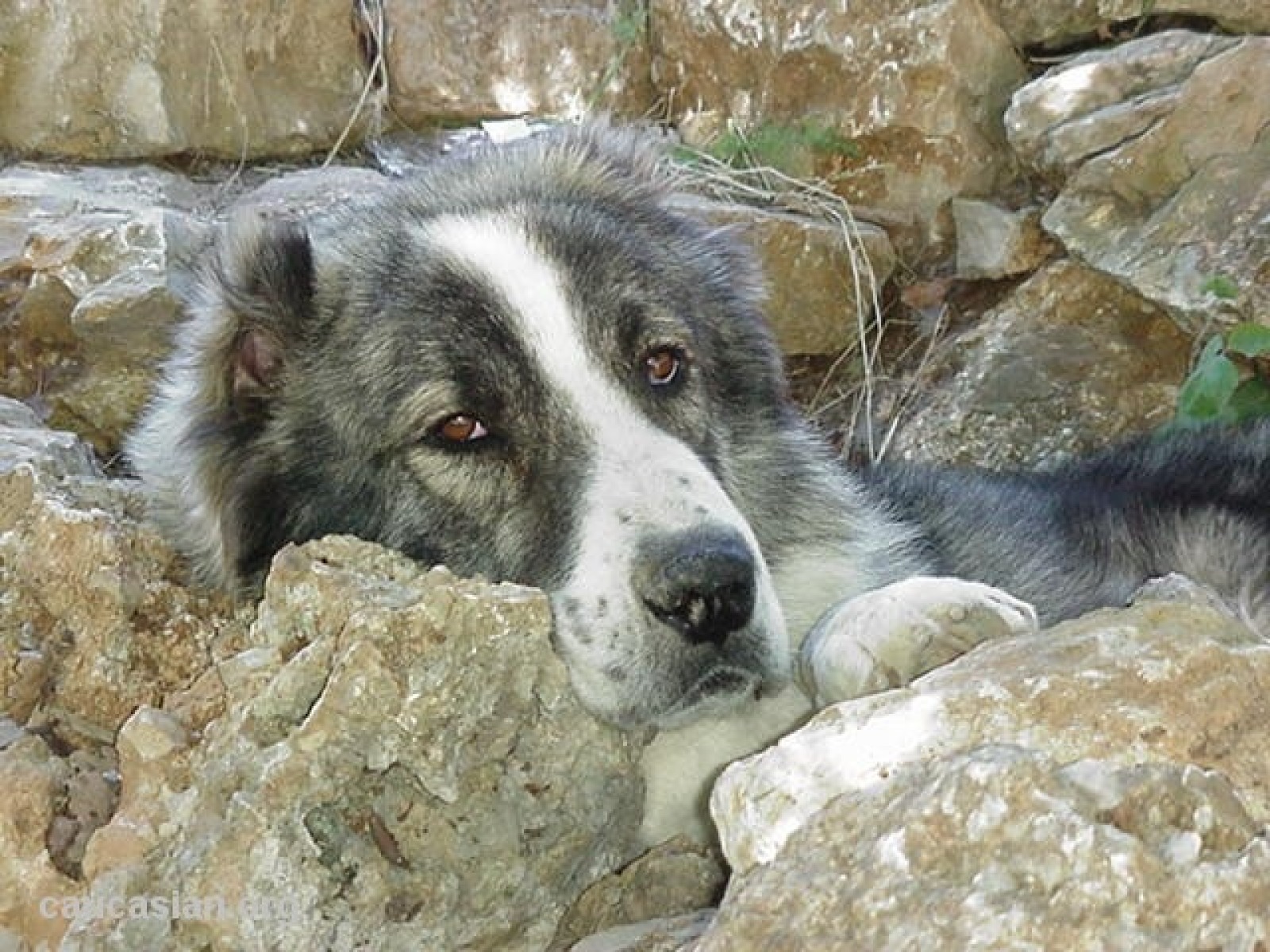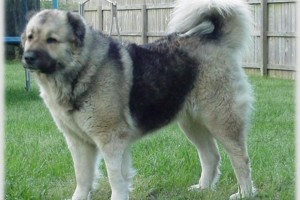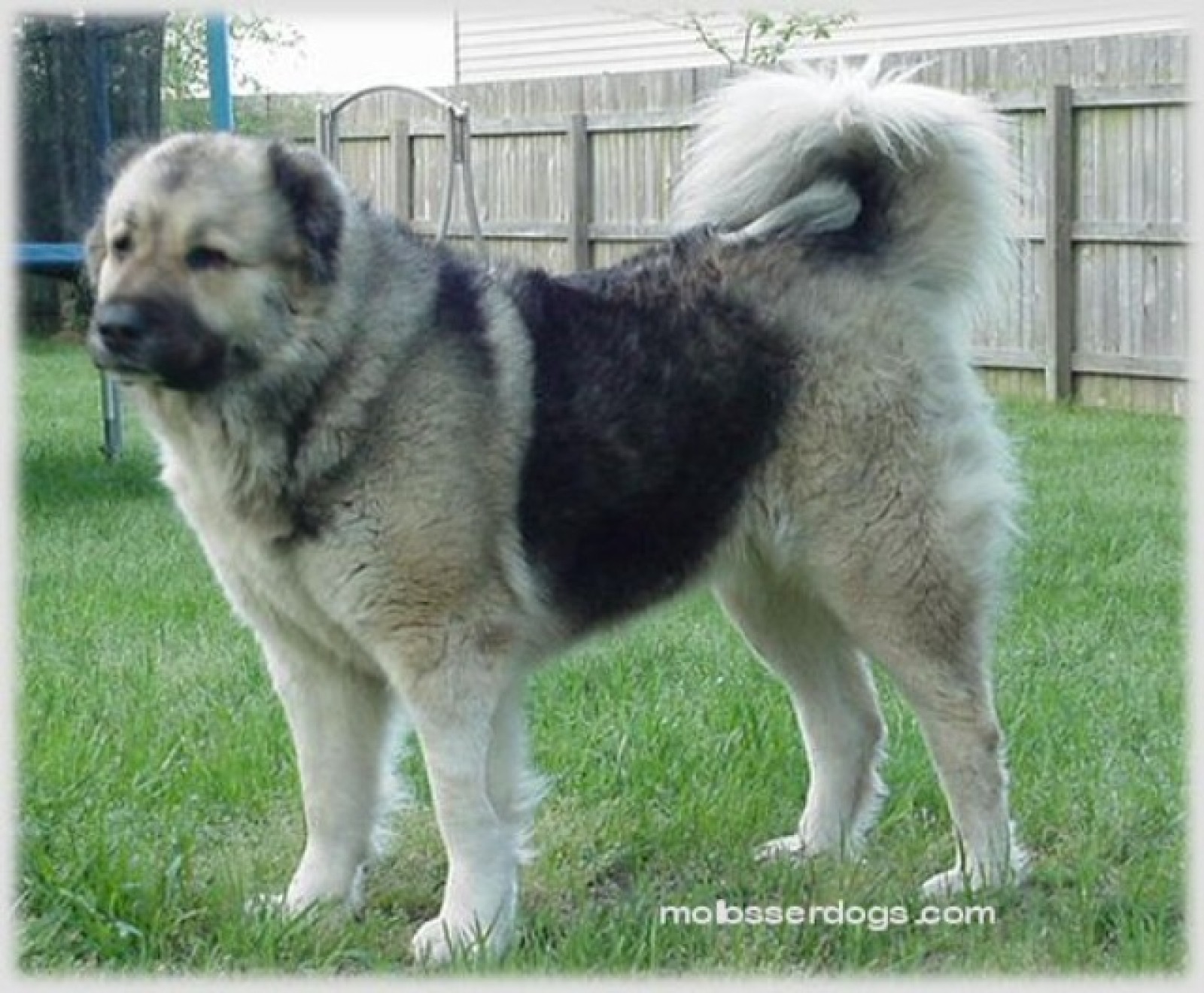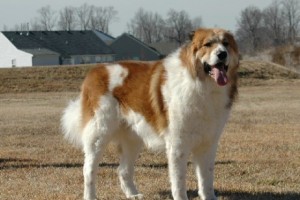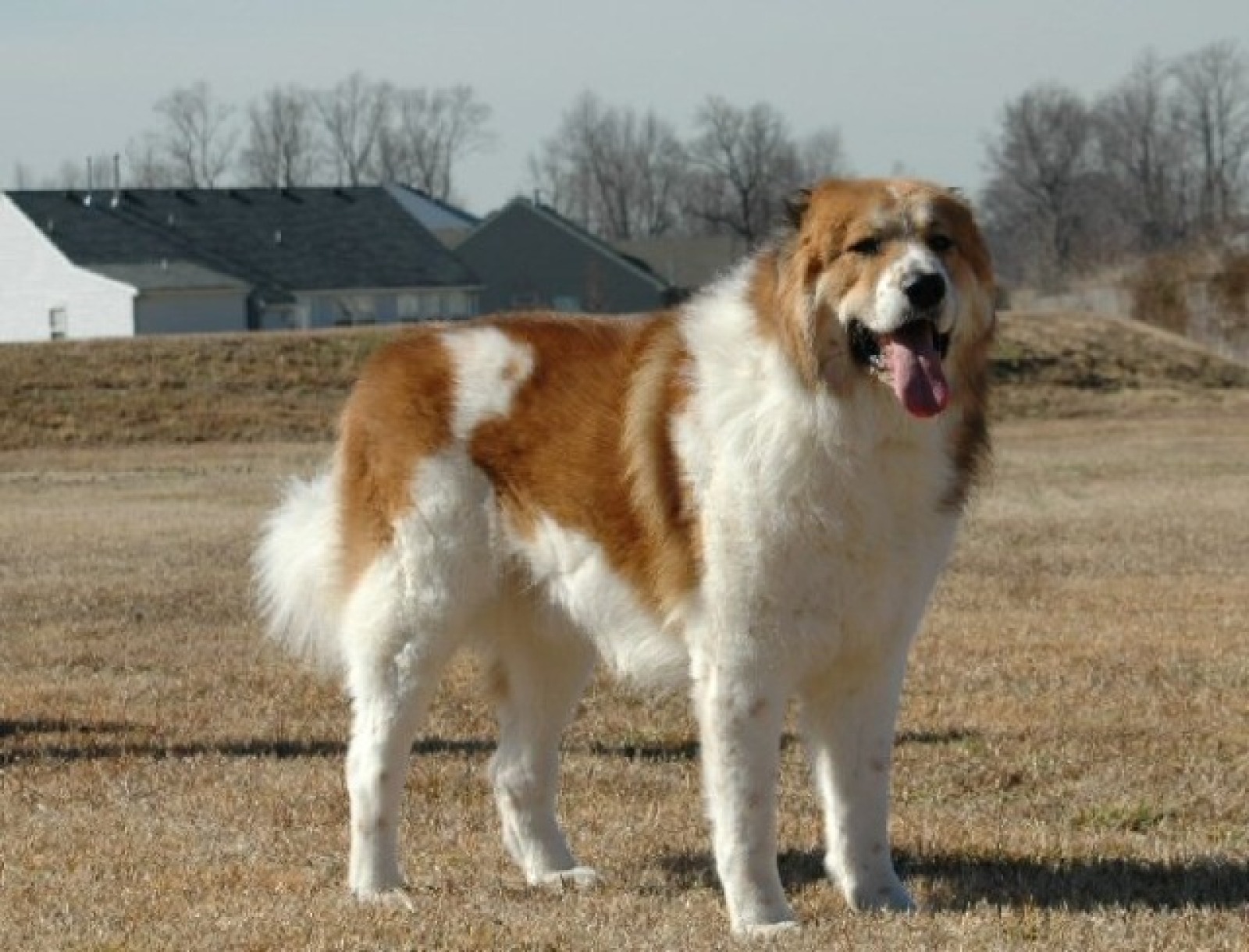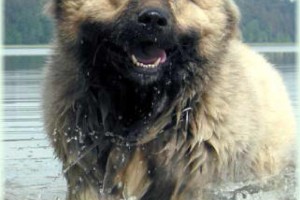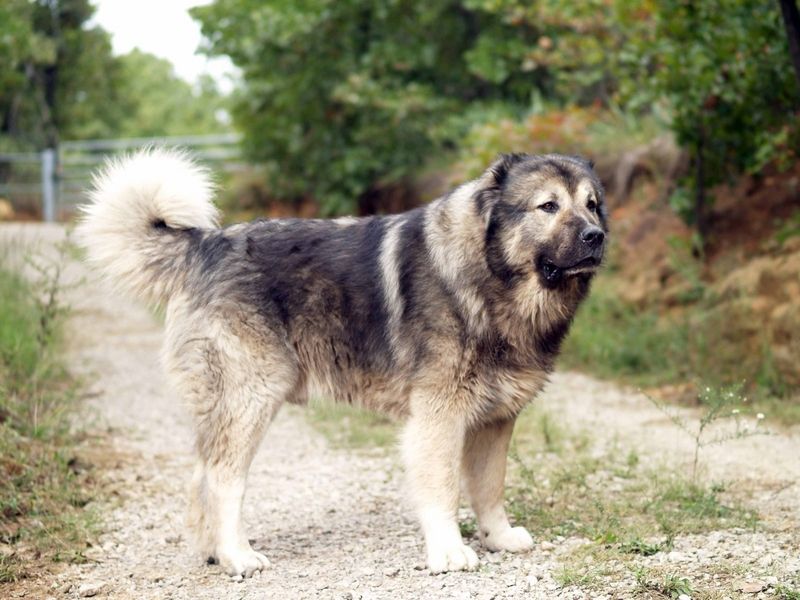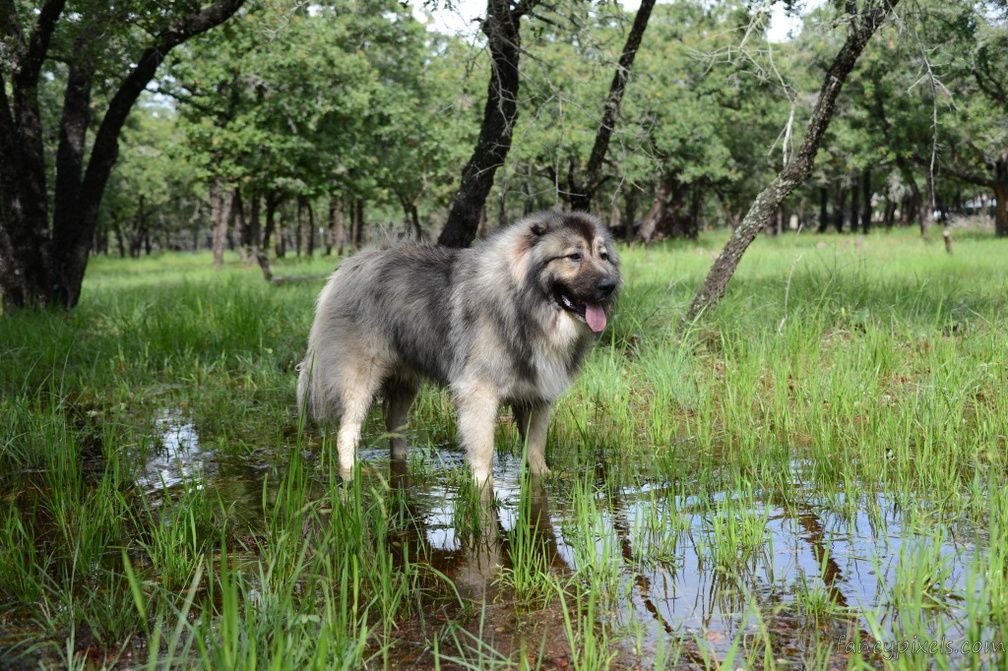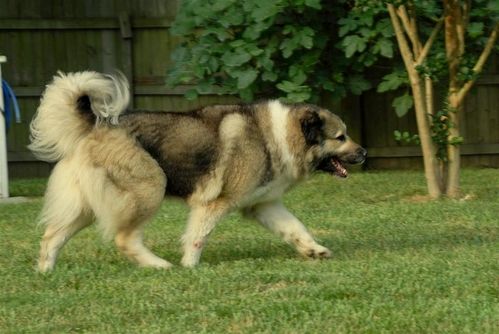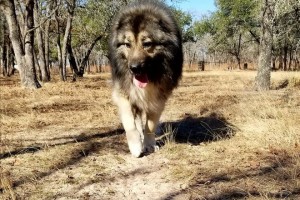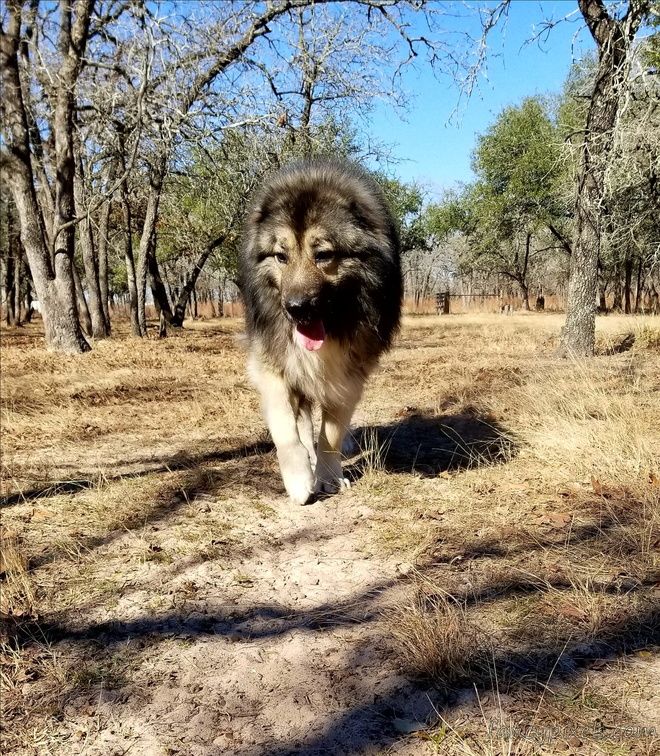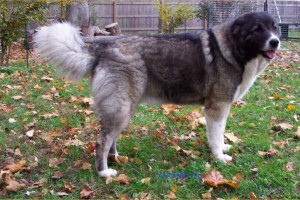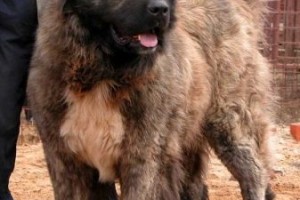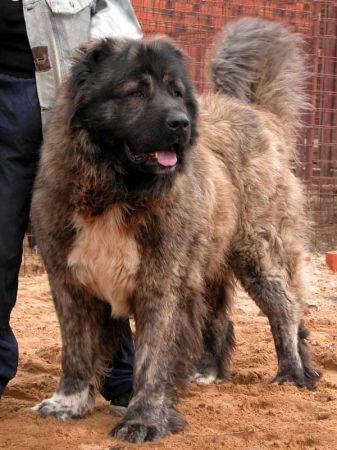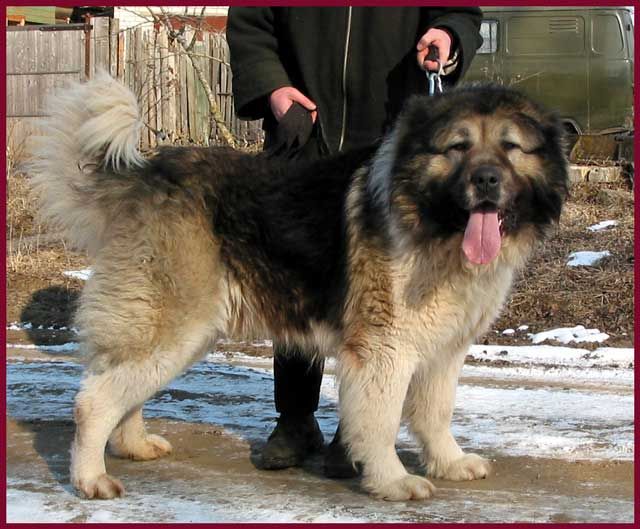A Miracle of Nature
DOSSIER – THE CAUCASIAN SHEPHERD
A MIRACLE OF NATURE
ITS REMOTE ORIGINS
In spite of the remote origins of the Caucasian Shepherd, only recently has this breed obtained worldwide official recognition (its standards were made official only in 1985). One of its ancestors is, without doubt, the legendary Tibetan Molosser.
We have watched this a thousand times in American police movies: two individuals, one white and one black, are arrested and sent to the Police headquarters where officers write down often without much tact these individuals’ personal data and take their photos.
Name, surname, year of birth, race. And an uncomfortable term: race. On the other hand, in America, you cannot do without describing the color of the skin of somebody who is wanted. This is why when one speaks about the black scoundrel the efficient police officer digits on the computer, as we would expect, the term "black", while when it is a white criminal to be involved the definition is not simply "white" but "Caucasian". Needless to say it is not a question of a Georgian wrongdoer or an Armenian throat-slasher, but of a more banal Irish wrangler, an Anglo-Saxon braggart, or even the Italian American accused as usual of being connected with Mafia. All go under the name of "Caucasians", according to the conventions of the American lexicon. We do not know precisely how this odd term developed, but it does not seem difficult to trace its history. Even before the word black took on its intolerably derogatory nature, the term "white" – or, worse, "Arian" - had started to assume a sinister taste because of the Nazis’ exaltation with it. The matter was, to say the least embarrassing and a better synonym was needed as soon as possible. Thus, having searched among thousands of anthropological theories of the epoch, experts found a more modern one. According to it, all Indo-European breeds traced their ancestry to a primitive stock born in the vast and fertile Caucasian highland. Today, very few believe that the Europeans’ progenitors actually originated from those mountainous regions; yet, the adjective "Caucasian" keeps proliferating in American judicial reports with its attendant aura of "politically correct".
The Caucasian Shepherd counts among its ancestors first and foremost the legendary Tibetan Molosser and maybe the St. Bernard as well.
The Caucasian Shepherd (the dog we are dealing with) shares with these not only the adjective that indicates their geographical origin but also the approximation with which it is attributed. Actually, the denomination "Caucasus" is nothing more than a mere geographical expression, even vaguer and more short-lived than the manner in which the Prince of Metternich envisaged the Italian peninsula. In 1922 the Soviets were contemplating the possibility of establishing the Republic of Caucasus. A few years later, having been persuaded by the evidence of facts, they subdivided it into Armenia, Azerbaijan, and Georgia. Within such a complicated mosaic of languages, religions, ethnic groups and customs, it is now the turn of the Ingushes, the Chechens, the Turks, and the Bats to ask for independence. Together they total to around 25 peoples in a territory as vast as Italy. This human Babylon is the Caucasus – and it is also a "canine" Babylon. Apparently (and officially) there is only a single Caucasian Shepherd, but experts can spend hours describing the characteristics that differentiate a Garbanski from a Kazbek, an Akhalt and a Gergetski. There is no doubt they are all Owtcharkas, that is "sheepfold - dogs"; despite this, differences do remain. Rather, it is a question of particular varieties that enrich and make even more remarkable a dog featured by absolutely unique characteristics.
It is even too evident that this breed originated from and has developed on the basis of the well-built Molossian hound from Tibet. Another genetic patrimony is likely to have contributed to the creation of the Caucasian Shepherd, but centuries and centuries of endogamy as well have undoubtedly favored a fixation of the peculiarities of this dog the history of which is mostly unknown. It is easy to identify the cases in which the Caucasian Shepherd has influenced the formation of new dog breeds (as it has occurred with the Leonberger or the St. Bernard), but such identification is not so easy the other way around. Some experts have formulated the hypothesis that in the XVII century some breeders of German origin performed surgery on the dog to the aim of enlarging its size. These breeders may have utilized a St. Bernard to the creation of which also contributed, as we have affirmed, the genetic patrimony of the Caucasian Shepherd. This fact, however, cannot be asserted with absolute certainty even because this dog has developed in regions remote from the researchers’ typical areas of study.
Indomitable and daring
The harshness of the Caucasian habitat has caused the development of a dog which, differing considerably from the typical shepherd dog, is, in fact, a strong, tempered animal always ready to give battle.
The Caucasus is a harsh land in which difficulties and perils abound. As in other areas of the world, here as well herding is far from being that lyrical and peaceful occupation which we all envision. Wolves, bears, and brigands have always raged through the highlands and whoever tended the flocks needed the close assistance of daring and resourceful collaborators. Therefore we should not let the label of "Shepherd" lead us to view the Caucasian as particularly skilled in governing herds. Rather, this is an intrepid watchdog, a real protector of the flock that can guarantee excellent watch skills in any climate and under every possible adverse condition. No breed is more rustic and solid than the Caucasian Shepherd. Its massive structure enables it to bear any attack; its long, thick fur makes it fit to withstand the most bitter cold and the worst storms; its Molossian-like character makes it a fearless and bellicose animal. The perfect companion for the man who has to move his flocks around the Caucasus, this dog cannot but be endowed with all these qualities. It may not be elegant, but these characteristics undoubtedly ensure survival in the harsh lands situated on the European-Asian border. This is why its head does not stretch out taking on that typical posture of false threat employed by other dog breeds to gain and keep the respect of the flock, but stands high and fierce, with piercing eyes that scan the horizon to keep alert in case an enemy should show up. Even the peculiar gait of this breed differs noticeably from that of a typical shepherd dog. The second walk with long steps that lightly touch the ground, whereas as it walks the first shifts from trot to a heavy and rhythmical gallop - which is exactly the same gait like that of a war animal.
A Demanding Companion
Do not deceive yourself: this is not a dog for everybody.
We would not go as far as stating that in order to share one’s life with an Owtcharka one needs to breed Caucasian flocks, yet there is no doubt its owner can not be the employee who inhabits a one-room flat in the center of Milan. The Caucasian Shepherd is demanding; it is strong and determined, powerful and bulky. In order to enjoy life with it one needs to provide it with ample room for its physical and mental activities. Physically speaking, a dog such as this cannot obviously be happy and content simply with a short afternoon walk in the park. Mentally speaking, the Owtcharka is used to entertaining with its traditional master - that Caucasian two-legged shepherd with whom it shares the denomination and the task – an intense and profound relationship based on mutual trust as well as the common purpose of tending their common property (the flock) and of defending it from any possible attack. This is where our friend, integrated in the more developed and sophisticated environment, will discover that its noblest and most satisfying concern consists in the defense of the property from any external threat. Whoever prefers not to stress these watchdog skills should opt for a female. A bitch will keep its definitely scrupulous and watchful character but may at the same time soften these skills with that sweet, warm touch typical of mothers of most species on Earth. In this animal, the watch instinct is particularly developed and since this is a stately Molossian dog, caution will always be needed. Its bond with children is not impossible but requires a period of adjustment in which to build a sense of confidence and all the quiet, which the surrounding environment can provide. The children and the animal may have known each other for a long time and may love each other deeply (the Caucasian Shepherd may display surprising patience for which he can be seen as having a lot in common with its distant cousin the St. Bernard). Yet, it is enough for this breed to perceive a threat, as vague as it may be, for its innate watch skills to be alerted, originating reactions which a child may not be able to predict and above all to keep under control.
ITS IDENTIKIT
Muzzle shorter than the skull
Large skull
Short, powerful neck
Tail set high
Large, oval paws
Original name: Kavkazskaia Owtcharka
Overall look. This dog, which is especially suitable for life in the countryside, has a strong skeleton and robust physical make-up. It is diffident and sharp with strangers but adapts well to all climatic conditions.
Head. Stocky with a wide skull and well-developed cheekbone arches. The forehead is wide and flat with a slight sulcus median. The muzzle is shorter than the total length of the skull; the lips are strong and dry; they adhere well without being pendulous. The nose is wide and black (brown is acceptable in the white and pale-yellow subjects). The eyes are small, oval and dark. The ears are hanging or cropped short and are set high. The teeth are robust and well developed and are featured by a scissors grip.
Neck. It is powerful, short, and carried rather low; it forms a 30-40 degree angle with the line of the back.
Trunk. The wide and muscular area of the withers stands above the line of the back. The loins are short, wide, and slightly arched. The rump is wide and almost horizontal. The abdomen is moderately retracted.
Limbs. Straight and parallel if viewed frontally. The angle that extends between the shoulder blade and the humerus measures approximately 100 degrees. The metacarpi are short. In the rear end, the hocks are sturdy and wide with slightly divergent angles. The paws are large, oval, and compact and do not open outwards.
Tail. It is set high and falls toward the lower portion of the body reaching the hock. It may be shaped like a scythe, a hook or a ring. Clipped tails are acceptable.
Coat. The hair is straight and rough in texture; the undergrowth, which is of a markedly lighter color, is well developed. It is shorter and well adherent on the head and on the front portion of the limbs.
Three sub-groups exist which can be classified depending on the length of the hair. Long hair: the top hair is longer; it forms a mane on the neck as well as fringes and "pants" in the upper portion of the limbs; a thick, big fur covers the tail. Short hair: the thick fur consists of relatively short hair; it forms neither a mane, nor fringes, nor "pants", nor a bush on the tail. Intermediate: the fur is long but it forms neither a mane, nor fringes, nor "pants", nor a bush on the tail.
Color. It is unevenly gray and has different shades (usually lighter and tending to red). Thus it may occur in red, rust, straw, white, and reddish-brown; it may also be striped, dappled, or irregularly spotted.
Size. The height at the withers must not be under 65 cms. for males and 62 cms for bitches.
Gait. Loose and regular, with a short trot. While galloping, the gait is rather heavy.
With all its physical features this animal, characterized by a primordial and powerful shape, calls to mind the hardship of life in a rugged, wild habitat.
This explains why it has not been difficult for this dog to find an occupation even away from its native land. The Congress of dog experts held in Moscow in 1952 was the one that awarded the Caucasian Shepherd its first official recognition. Increasingly appreciated since then, this breed has eventually come to be famous in a vast area that comprises Georgia, Armenia, Kabardino-Balkaria, Azerbaijan, Astrakhan, Dagestan and the steppes of northern Caucasus. Although a real standard has only been imposed since 1985, in the last two decades this breed has been displayed more and more often in exhibits and international shows and has always been given a good reception. In effect, to be able to approach a dog with an appeal as primordial and essential as this is a rare experience. This animal is characterized by a considerable size; the height of males at the withers must not be under 65 cms. Its stocky, compact head is featured by a large skull and well-developed cheekbones. A slight furrow bisects the flat and wide forehead and the stop is not very noticeable. The muzzle is rather short and not too sharp; the strong, dry lips hide a powerful set of teeth that closes perfectly with a scissors grip. The ears are erect and cropped short, the nose is strong, large and black (however, brown pigmentations are acceptable in the subjects in which the coat is white or clear straw); the eyes are dark, small, oval and deep-set. Such a statuesque head must necessarily stand on a neck, which, although rather short, is very strong. The breast as well is powerful, wide, high and slightly rounded; the lower section of it is at the same height as the elbows, or lower. The withers are muscular and wide, positioned well above the straight line of the back. The loins are short and wide; the same can be said about the rump, which is almost horizontal and extraordinarily muscular.
From the differentiation in the coat, which is always strong and suited for any climate, come three varieties of Owtcharka
The anterior limbs are straight; the forearms are strong and moderately long, while the metacarpi look short and powerful.
The posterior limbs too are straight and parallel; the hocks are strong and the metacarpi are robust. The paws look large, oval and compact. The ensemble of these characteristics enables the animal to move around with a uniform and easy gait. Most of the time the gait consists of a short trotting which if necessary turns into galloping. The tail hangs toward the lower portion of the body and is set high. It may look like a scythe, a hook or a ring and its fur is always very thick. Experts accept but for the most part, do not recommend the cropping short of tails. As for the coat, it is formed by straight and very coarse fur the protective function of which is enhanced by a well-developed undergrowth of a lighter color. The fur on the head and on the anterior portion of the limbs does not look so thick as it does in the rest of the body.
The coat, however, differs from subject to subject and at least three types exist. First comes the Owtcharka in which the long fur forms like a mane around the neck as well as "pants" and bushes on the posterior sections of the limbs and of the thick tail. Next comes the shorthair type, which is endowed with a thick, uniform coat. Last comes an intermediate type, which does not have such excessive features as manes or bushes but is still endowed with an attractive, thick coat with long hair. When it comes to its color experts are not excessively finicky and consider as acceptable gray, tawny, straw, white, reddish, red-striped or dapple. Only black and brown are not acceptable.
Bellicose but not quarrelsome
The Caucasian Shepherd is physically strong but psychologically well balanced, bellicose but not quarrelsome. It is endowed with a marked sense of personal property, which represents the main point of reference to its conduct: there is nothing that may frighten it or place it in a state of inferiority.
AN AFFECTIONATE FRIEND FOR THE ENTIRE FAMILY
The English zoologist Desmond Morris, author of the world-famous "The Naked Ape" (1968), affirms: "We see animals not as such, but rather as a reflection of ourselves". This important concept can be borrowed to explain those feelings of "love at first sight" which at first make a dog expert fall in love with a breed and then turn him into a breeder. The inspirer of this passion is generally the outward aspect of a breed; somehow or other this element triggers ancestral desires which then find their concrete outlet. Some years ago I was fascinated by the photos of some Caucasian Shepherds published in a magazine. I then made acquaintance with a lady who had already been breeding them for a number of years. I found myself literally dazzled by a male which I would define as "terribly gorgeous" and which was to father the first subject (this, too, a male) of my own farm. To see this breed and choose it, in conclusion, have been for me all the same".
What strikes in the first place is, indisputably, that combination of majesty, power, and beauty, which is so peculiar to it; a significant role is also played by its fascinating history, which in its own way has molded its personality. This animal, for a long time accustomed to working with herds and often separated from man for many days in a row, has developed a fiery, courageous and incredibly determined personality. It is generally diffident with strangers - which is normal, considering its past. Within the family, on the other hand, it is gentle to everybody. This happens because, unlike other dogs with a history and an aptitude and vocation similar to its own, it does not select as a head of the herd a single member of the family, but establishes a truly intense rapport with all its members. Furthermore, if it is allowed to get to know and to play with the visitors of its household, it will relate to them nicely. Years later it will recognize them as if it had just encountered them for the first time.
At this point, the obvious question is, what type of individual could best match an animal like this which, in the opinion of experts, is equipped with a stable nervous system, a strong build, and a medium-to-high level of aggressiveness, paired with quite marked docility? It is imperative for it to live in a garden considering that - despite its massive size – this is an active and athletic dog. She adds: "I would say that the prospective owner of a Caucasian Shepherd should be self-confident and calm because even as a puppy this dog tends to impose itself as the leader of the herd. To prevent this domineering tendency from becoming excessive, it is a must for its owner to be a calm individual who would not be frightened by even the slightest attempt of the dog to disobey". The Caucasian Shepherd, which has a healthy and robust physical make-up, is not subject to the pathological conditions typical of its breed and does not create any major problem even from the viewpoint of its diet. I suggest always feeding it with top-quality dry food. By doing so do it can be guaranteed a safe and balanced diet even in light of the fact that its growth normally proceeds by discontinuous "spurts". Finally, for its maintenance, I suggest avoiding extra-energetic foodstuff to ward off possible skin allergies.
THE WEAK SPOTS
*Since fearlessness and bellicosity represent two essential traits of good Owtcharkas, the choice of the prospective owner should not fall on those puppies that show an excessive fear of strangers or even step back from them. As this is a dog featured by a strong temperament and a considerable handsomeness, the subjects that display an excessively and inappropriately quarrelsome temper will evidently have to be excluded from selection.
*It is now indispensable to list the most serious defects that subjects of this breed may display: a size inferior to standard; soft or wavy hair; a missing undercoat; a lightweight head; a low setting of the ears; low rimae palpebralum (an hereditary anomaly typical of the Caucasian Shepherd); an incomplete or ill-disposed set of teeth; a long neck; a hanging abdomen; an underdeveloped breast; a dome-shaped or humpbacked back; a short rump; arched limbs; spread-out or flat paws.
*Much the same as all well-built, large dogs, the Caucasian Shepherd as well needs a really balanced diet in order to grow strong and healthy. A good veterinarian will follow its growth and will introduce an adequate variety of food with the proper amount of vitamins, proteins, and minerals to match its diet perfectly with the nutritional needs of the various phases of its life.
Within only a few years it has won the heart of the Americans
Information regarding the Caucasian Shepherd can not be found easily on the Internet not because there is no site devoted to it but because (as you can discover during your search) this dog is called with many different names: "Caucasian Ovtcharka", "Owtcharka", "the dog of Caucasian mountains", and also, just to exemplify, "Kavkazskaya Ovtcharka". But as you navigate the sites devoted to it throughout the world you will find out that the denomination under which it is known universally, and the one under which you can find most information about it, is LGD (Livestock Guardian Dog).
In the former Soviet Union, these stately dogs were considered a national patrimony; thus, their export was forbidden. Subsequently, with the breakdown of the "red empire", Ovtcharkas have started to become popular in Western countries as well. Today in America there are around two hundred subjects officially recognized by the American Kennel Club, but the ones imported illegally are even more numerous. This explains why so many Caucasian Shepherds have been forsaken. Benjamin Levi, a gentleman of Russian origin who is very fond of this breed, has set up a shelter for homeless Caucasians. If you wish to collect information or to buy one of these dogs please contact Ben Levy (ben-levy@westworld.com). [note: molosserdogs is not sure if Ben is still into the breed] Even the notorious KGB used to breed Ovtcharkas. From the kennels of the KGB, indeed, comes Lucvky, a very large dog defined as "extremely protective".
The geographical isolation of some areas and the harsh life of others have produced four varieties of Caucasian Shepherd. According to some experts, all of them may someday come to be qualified as real breeds.
The length of the fur is not, however, the only point of reference for the recognition of different varieties within the general breed. As already mentioned, some experts even talk about four separate types of Caucasian Shepherd, each of them being related to a different area of origin. One is the Gergetski, which originated in the mountainous Dagestan and is characterized by a large size, a long fur and muzzle, and a gray or reddish coat with white dots around the mouth. Opposed to this is the Kazbek, which comes from the mountains of northern Georgia, has a coat that is often striped and is as large as but more elegant than the first. The Garbanski, which comes from the barren lands of Azerbaijan and Georgia, is instead a hybrid created by crossing the Owcharka with the Turkish Shepherd. Finally, there is the Akhalt from Dagestan. This dog, which is characterized by a coat of every possible chromatic tonality and often by yellow eyes, can be said to have been obtained by crossbreeding the other types. Some experts would like these varieties to come to be recognized as real breeds, but such recognition is still very far from coming. After all, the Caucasian Shepherd has not yet spread widely through western countries. Only starting from 1979 have some subjects started to be displayed in European shows, while as for the Italian dogs the first Owtcharka, the very beautiful Riuslan von der Alten Ybbs, was officially presented in the International Show of Bellagio in 1986. Yet, to learn more about a dog that is so simple and pure in its primitive rusticity would really be worth the effort. This animal is strong but balanced, fierce but not quarrelsome. Its most peculiar behavioral trait consists in the extremely strong sense of property, which it views as a real and primary point of reference of its behavior. Nothing can frighten it or place it in a state of inferiority. Even when attacked by larger or numerous enemies the Caucasian Shepherd is always ready to reveal all of its prowess to protect the life of its master and of his sheep.
It is awesome
The short and not excessively sharp muzzle of the Caucasian Shepherd and its strong dry lips conceal a powerful set of teeth featured by a perfect scissors grip. But it is in the ensemble of its characteristics that this stately dog of the East expresses strength and power, arousing an instinctive feeling of awe in whoever approaches it.
AN ITALIAN PURE-BREED CLUB
The Club Italiano Amatori Owtcharka (the Club of the Italian Lovers of Owtcharkas) (C.I.A.O.) has been established recently but it has not been officially recognized by the Enci yet. Its President is Mr.Augusto Pollacci (Via Convertino 1651/C , Bologna) and its secretary is Mr. Fabrizio Caroli (Via Canton 49, Rome).
ITALIAN BREEDERS
CHATO owned by Antonella Ghidini, Via A. Colombo 58, 21055 Gorla Minore, VA (tel. number: 0331-600591)
DEL MURTOI'S owned by Milena Mura, Loc. Piano 15070 Lerma (AL) (tel. number: 0143-877197)
DEL FlUME BIANCO owned by Giuseppe W.Menicucci, Via Silea 34 19034 Sarzana (SP) (tel. number: 0187-622517)
DEL GHIARDO owned by R. Giglioli, Via Sottili 6, 42020 Codemondo (RE)
DEL NADIR owned by Giorgia Luparia, Castelletto Monferrato (AL)
DELLA COTEA owned by A.. Rellini, Via Forlivese 96/98, 50060 Contea (FI)
I CANI DI JACOPONE DA TODI owned by Franco Simoni, Via Matteotti 84, 06059 Todi (PG)
DELL’ALTO JONIO owned by L.Lasso, Via Matteotti 15, 87065 Corigliano C. Scalo (CS).


